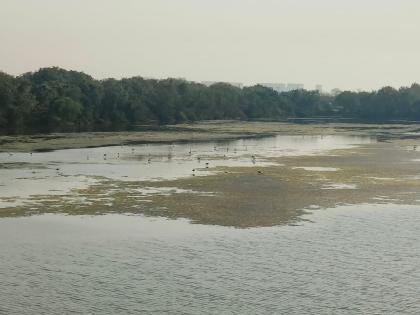Navi Mumbai: DPS Flamingo Lake Declared Conservation Reserve by State Wildlife Board
By Amit Srivastava | Updated: April 17, 2025 21:08 IST2025-04-17T20:58:37+5:302025-04-17T21:08:20+5:30
The Maharashtra State Wildlife Board, on Thursday, April 17, 2025, approved the long-pending proposal to declare the 30-acre DPS ...

30-Acre Flamingo Habitat Near Navi Mumbai Gets Official Protection
The Maharashtra State Wildlife Board, on Thursday, April 17, 2025, approved the long-pending proposal to declare the 30-acre DPS Flamingo Lake a conservation reserve. The decision comes after persistent efforts by local residents and environmentalists, who had campaigned tirelessly—including forming a human chain—to demand protection for the lake. Their dedication has finally paid off, and they have welcomed the move with great enthusiasm and relief. Forest Minister Ganesh Naik played an important role in spearheading the demand and advancing the proposal at the government level.
This marks the first time a wetland from the Thane Creek Flamingo Sanctuary’s (TCFS) satellite ecosystem has been granted such protection. Flamingos from TCFS often flock to these satellite wetlands during high tide, making them critical to the birds’ habitat.
The Board, which convened in Mumbai, ratified the proposal along with strong public support. Forest Minister Ganesh Naik, who also serves as the Board’s vice-chairman, played a pivotal role in pushing the recommendation at the government level. He emphasized to the members that protecting the lake as a sensitive ecological zone is vital for preserving the city’s biodiversity.
Chief Minister Devendra Fadnavis, who chaired the meeting, confirmed that the proposal listed under agenda item 4.1 was approved.
The move gained momentum after B N Kumar, director of NatConnect Foundation, submitted a recommendation from a high-level government panel to Minister Naik. Responding swiftly, Naik forwarded the proposal to the Principal Secretary of the Forest Department, urging immediate action to conserve the lake.
The panel was set up following a tragic spate of flamingo deaths around the DPS Lake early last year. According to information obtained by NatConnect through an RTI, the committee was tasked with identifying measures to protect the fragile flamingo habitat.
Kumar expressed satisfaction at the speed with which Naik acted. However, he also voiced regret over the loss of 17 flamingos when the lake dried up after tidal inlets were blocked due to the construction of an access road to the nearby Passenger Water Transport Terminal.
During a site visit, Minister Naik observed the deteriorating condition of the lake and ordered two tidal inlets to be reopened. He also directed the Navi Mumbai Municipal Corporation to lower the inlet pipes to restore natural water flow. A Forest Department official later reported that 60% of the accumulated algae had been cleared from the lake.
Groups like NatConnect, Navi Mumbai Environment Preservation Society (NMEPS), Save Flamingos and Wetlands Forum, and Kharghar Wetlands and Hills Forum had formed human chains twice last year to raise awareness about the lake’s plight.
Sandeep Sareen of NMEPS called the Board's decision a “collective victory for all environment lovers.” He also submitted a memorandum to Minister Naik during a recent Janata Darbar.
With partial restoration of the water flow, flamingos have returned in significant numbers to DPS Flamingo Lake, reaffirming its importance as a vital habitat.
The lake is part of the Ramsar-designated Thane Creek Flamingo Sanctuary’s extended ecosystem, which includes other key wetlands like Panje, NRI, and T.S. Chanakya. These serve as resting and feeding grounds for flamingos during high tide.
The Bombay Natural History Society (BNHS) has consistently recommended the conservation of these satellite wetlands as part of the TCFS management plan. It warns that disturbing these zones may drive the birds toward uplands near the upcoming Navi Mumbai International Airport (NMIA), increasing the risk of bird strikes.
Notably, the Adani Group-managed NMIA, in its environmental impact assessment and compliance reports to the Centre, acknowledged this risk and committed to following BNHS recommendations to maintain biodiversity around the airport, Kumar pointed out.
Open in app